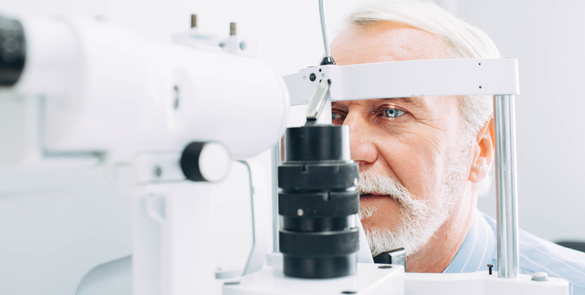Adult squint, or strabismus, occurs when the eyes do not align properly. Although often associated with children, it affects about 4% of adults and can be caused by a range of factors.
In adults with a squint, one eye looks straight while the other may drift inwards, outwards, upwards, or downwards, leading to symptoms such as double vision, eye strain, headaches, reduced depth perception, and blurred vision. The visible misalignment can also impact social interactions and self-confidence.
Early diagnosis and treatment of adult squint can significantly improve vision and quality of life. At Moorfields Eye Hospitals Dubai and Abu Dhabi, our expert team uses advanced techniques to effectively diagnose and treat adult squint.

Causes of Squint in Adults
Adult squints are of three main types: non-paralytic, paralytic and restrictive.
- Non – Paralytic Squint: In some adults, a squint from childhood may return later in life, even if it was treated or surgically corrected. These cases are generally non-paralytic, meaning the eye muscles are not weakened.
- Paralytic Squint: This type is due to weakened or paralyzed eye muscles, often resulting from nerve damage. Causes include head injuries, strokes, or conditions like diabetes and high blood pressure.
- Restrictive Squint: This occurs when eye muscles are restricted, limiting movement due to factors like scarring or muscle tethering.
Symptoms of Squints in Adults
Adults with squints may experience:
- Double Vision (Diplopia): Seeing two images due to eye misalignment.
- Eye Strain and Fatigue: Especially noticeable during near tasks like reading.
- Difficulty with Close-Up Vision: Using a computer or reading may become challenging.
- Abnormal Head Posture: Tilting or turning the head to reduce double vision.
- Loss of Depth Perception: Difficulty judging distances, affecting daily activities.
Risk factors for developing Squints in Adulthood
Several factors increase the likelihood of adult squints:
- History of Childhood Squint: Untreated squints or previous squint surgeries in childhood may lead to issues in adulthood.
- Neurological Disorders: Conditions such as stroke or brain injury that affect eye muscle control.
- Medical Conditions: Diseases like diabetes or thyroid disorders increase the risk of squints.
- Trauma: Injuries to the eyes or surrounding structures can disrupt normal alignment.
- Age-Related Changes: Muscle and nerve changes from aging can cause squints, even in adults without prior eye issues
Diagnosing a squint in adults requires a thorough eye exam by an ophthalmologist or orthoptist, including:
- Eye movement and alignment tests: To assess how the eyes move and measure alignment.
- Eye coordination tests: To determine how well the eyes work together.
- Visual acuity test: To check for any vision loss.
- Refraction testing: To evaluate refractive errors.
- Imaging: Scans may be used to find underlying causes.
- Blood tests: Tests may be carried out to identify any underlying systemic condition
Treatment for squint depends on the severity and there are several approaches to treatment.
- Conservative Treatment: In some cases, eye exercises or prisms can help manage symptoms, particularly if the squint is changing or resolving.
- Non-Adjustable Surgery: This procedure, done under general anesthesia, adjusts the eye muscles to improve alignment. It usually takes about an hour, with most patients going home the same day.
- Adjustable Surgery: A two-step approach that involves:
- Main Surgery: Eye muscles are repositioned under general anesthesia.
- Adjustment: After waking, the final muscle position is fine-tuned using adjustable sutures, usually under local anesthesia. This method is beneficial for patients with complex cases, previous surgeries, or double vision. Adjustment may cause slight pressure or discomfort.
Goals of Squint Surgery for Adults
Squint surgery for adults aims to:
- To improve the alignment of the eyes, to make the squint smaller in size.
- In some patients, to reduce or try to eliminate double vision.
- Occasionally to improve an abnormal position of the head.
Post-Operative Care
After surgery, patients may experience mild discomfort, redness, or swelling that usually subsides within a few days. Post-operative care includes:
- Use the eye drops to reduce infection risk and control inflammation
- Use painkillers such as paracetamol and ibuprofen if the eyes are painful
- Use cooled boiled water and a clean tissue or cotton wool to clean any stickiness of the eyes and avoid water entering the eyes from the bath or shower for the first two weeks
- Do not rub the eye(s) as this may loosen the stitches
- No swimming and heavy lifting activities
- Attend the post-op clinic appointment to monitor healing and alignment.
- Continue using glasses if you have them
- Avoid contact lens wear in the operated eye(s) until advised it is safe by the doctor or orthoptist.
While many patients notice improvement within weeks, full recovery can take a few months, depending on the case.
Request an Appointment



